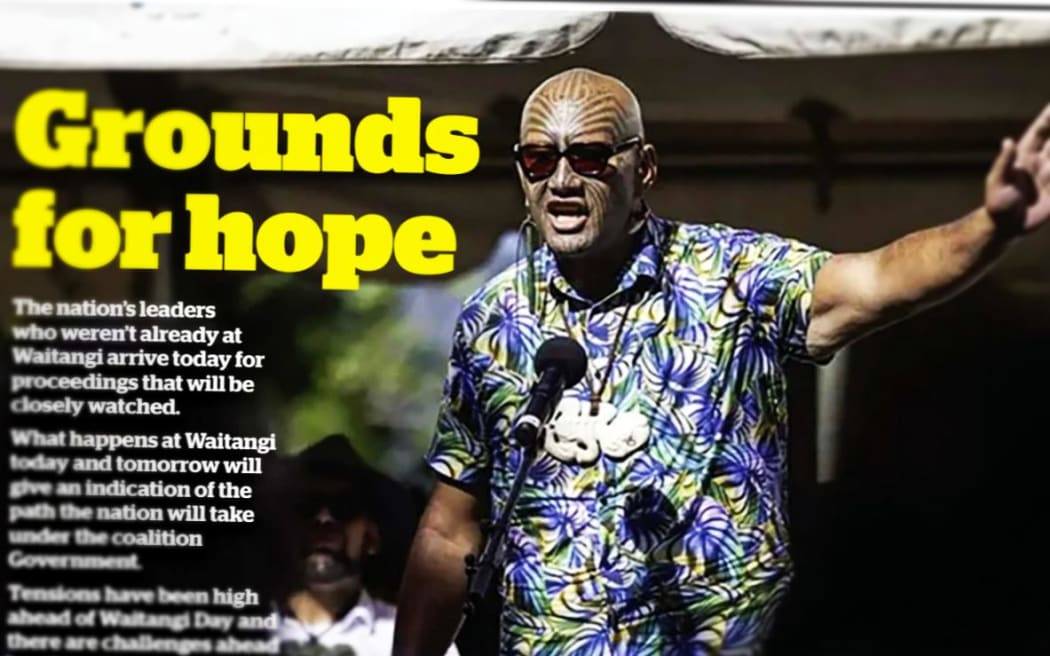In past years some media outlets were ambivalent about Waitangi Day - some even hostile at times. But new moves by the new government and a strong pushback from Māori gave it an extra edge this year. Some even called it historic and a possible turning point. How did the media depict all that?

The front page of the New Zealand Herald last Monday - the day political leaders spoke at Waitangi. Photo: New Zealand Herald
Ten years ago the New Zealand Herald printed a raised white fist on its masthead along with the promise its Waitangi Day edition would be “protest-free".
The Herald said that was the paper’s own protest at other media focusing on protest.
One year earlier, the Herald published a column by Paul Holmes calling it “our repugnant national holiday” in which he also branded protesters delusional "hateful, hate-fuelled weirdos".
In 2016, Herald columnist and ZB radio host Mike Hosking declared there was "no point in celebrating . . . an annual ritual of abuse, anger and ignorance".
Three years later in the Herald, Hosking deemed it “a highly niche outing” amounting to a “day of grievance".
But this year, even after predictions of tension and protest, the Herald was more rosy on 5 February.
"There are challenges ahead but there is also room for optimism, hope . . . and humour," its front page said.
That was the day political leaders made their speeches. And the next day - Waitangi Day - the Herald editorial declared: 'The theatre of Waitangi was wonderful'.
It credited the PM for attending Rātana and also meeting iwi leaders before Waitangi “even though some might not like what he has to say".”
"But the thousands at Waitangi - including those marching in the hīkoi - show the level of opposition Luxon will face. This is where his hard work begins," the Herald added.
The paper's front page headline featured the government's three leaders - and the headline: 'Up for the challenge?'
The media had a challenge too: explaining and understanding the united front that formed among Māori in advance of commemorations - as well as what the politicians had to say.
Winston Peters rose to the challenge on the paepae with what Stuff’s Adam Dudding described as “a brief, angry spray", telling his critics to “stop the crap … stop the hysteria".
In the Herald, Simon Wilson said Peters claim “that the people in the crowd did not have his own long history of fighting for Māori rights” was “preposterous”.
“The crowd was full of people who have been doing exactly that for most of their lives. All those kuia and kaumātua sitting around under the trees: Peters knows full well who they are and the immensity of their contributions.”
Peters' deputy Shane Jones did too. Blake Ihimaera - a co-host of the TVNZ / Whakaata Māorii joint special - made that clear when she asked him if he would be joining the protesters afterwards.
“Many of my own whānau will be in that protest group. I see a lot of young protesters there. They belong to the local church groups, their local kapa haka, the local schools. They are school teachers, they’re laborers, they’re university students. We should get jealously guard our liberties and our freedoms - and many of them are traceable to the Treaty of Waitangi.”
There were more bluster-free and intimate interviews like that - conducted away from the heat at the Treaty grounds - in what TVNZ billed as “a celebration of Te Tiriti o Waitangi through the eyes, songs, laughter and characters of those involved".
Three other fully bilingual co-hosts anchored the coverage alongside Blake Ihimaera - Peter Lucas Jones of Te Hiku Media, Pere Wihongi and Turia Schmidt-Peke.
They’re not household media names, but TVNZ and Whakaata Māori’s coverage from Waitangi was carried to households nationwide last Tuesday.
Ctrl+C; Ctrl+V PM?
It was the PM’s speech that got the biggest reaction from media, perversely because it was the opposite of inflammatory.
Stuff’s Adam Dudding called it “a speech so magnificently banal that even the angriest of critics forgot to boo at him".
The Spinoff editor Madeline Chapman said it was so boring it was insulting.
And in his stated determination to talk about taking the country forward, the PM went back in time a year.
After social media user Spiderhoof stitched together video showing that parts of this year’s Waitangi speech were the same as in 2023, the media seized on it.
In print, Stuff’s Tova O’Brien said Luxon’s speech “actually landed about right . . . after his deputy prime ministers had let rip".
But in her Waitangi podcast - Wairua, waiata and wero - she criticised him for not speaking to reporters afterwards.
Newshub’s Amelia Wade also confronted Luxon about “gapping it” after the dawn service, without giving reporters the time of (Waitangi) day.
Why would he do that?
Last year, when he was National party leader, TVNZ headlined a supposed controversy when Luxon's speech referred to the Treaty as “a little experiment".
He later spelled out what he meant in interviews which took the sting out of any 'controversy'.
He also copped flak for using cue cards.
“Whaikorero is the lifeblood of the marae and is usually spontaneous,” said Newshub’s political editor Jenna Lynch at the time.
“Using those cue cards looks a bit weird, but also it speaks to Luxon's self confidence and the confidence he has in what he is saying. It doesn't help with the authenticity issue.”
Luxon was failing to cut though in political opinion polls at the time, but it wasn’t really a big deal at Waitangi Day 2023.
“So strong is the expectation that Waitangi must be mired in controversy that when there is none, it has to be invented,” the Herald’s Audrey Young noted at the time.
Some commentators said the problem with the PM recycling last year’s message “for clarity” was that so much has changed since then.
He now leads the government, but in his speech sidestepped issues like the Treaty Principles Bill, the rollback of te reo in the public service and scrapping the Māori Health Authority.
Concerns about all that had been made plain to him recently at Rātana and the iwi leaders forum - and also aired at the Kingitanga’s hui a motu at Tūrangawaewae recently.
“The Kingitanga has well and truly built on the momentum it created - and the presence has set Waitangi alight. The energy they brought to the treaty grounds was nothing short of profound. The concerns of te ao Māori have been laid out. And all that's left now is for the government to front up to it,” TVNZ’s Te Aniwa Hurihanganui told 1 News viewers the day before politicians spoke on the paepae.
“I think this is special because of the Treaty Principles Bill, They're here because they don't have any assurance from the current government. They're looking for answers - and when they don't understand, that's met with frustration,” Far North Regional councilor Penetaui Kleskovic said in Whakaata Māori’s coverage on Waitangi Day.
While the ACT leader was unhappy about being drowned out on the paepae on Tuesday, he took every opportunity to speak about what ACT wants in the media - and there were many.
The Herald published a Waitangi Day piece by David Seymour headlined We don’t believe Treaty of Waitangi is a partnership between races. Mihingarangi Forbes devoted an edition of the podcast Mata to Seymour.
The return of TVNZ’s Q and A on Waitangi Day was devoted to the Bill and the ACT Leader featured heavily in it alongside opponents and analysts.
During the TVNZ / Whakaata Māori broadcast, Peter Lucas-Jones pressed both Seymour and Luxon who had actually written the principles in the ACT-sponsored Bill.
Battle of the Bill
After heavy questioning from the Press Gallery on Wednesday, Luxon confirmed for the first time National wouldn’t back the Bill beyond the first stage.
But hours earlier ACT launched a new information campaign and a website to change public hearts and minds.
It’s not the first such effort.
Last week newspaper readers around the country found an eight-page interpretation of the Treaty in their paper - paid for by the Centre for Political Research (CPR) led by former Act MP Dr Muriel Newman.
The piece an interpretation of the Treaty was written by pioneering Māori statesman Sir Apirana Ngata back in 1922 - and it reinforced the notion that signatories did cede sovereignty back in 1840.
The CPR - which misprinted its own web address in the publications cover - said this was to stimulate debate ahead of Waitangi Day (Surprisingly the 1922 article is not available on it website anyway).
Treaty scholar and lawyer Carwyn Jones told Radio Waatea the 1922 interpretation was to say the least a contestable view today - and scholarship over the past 50 years had advanced understanding of the two versions of the Treaty.
“People don't suddenly become experts by reading one piece and we need to be very careful about cherry-picking . . . a particular ideological perspective. And it's really interesting to see money going into circulating this one particular perspective of the Treaty,” he told Radio Waatea (later explaining in detail for The Spinoff).
The Herald and Newshub this week declared the Treaty Principles Bill “dead in the water” - but a political push for change will go on.
Getting debate and conversation going through the news media will be a big part of it. Politicians and the media alike will have to work out how to respond to it.


